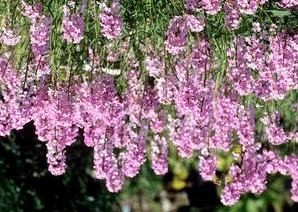Persian stonecress
(Aethionema grandiflorum)

Description
Aethionema grandiflorum (Synonyms: Aethionema pulchellum) commonly known as Persian stonecress or Persian candytuft, is a flowering plant in the family Brassicaceae, preferring to grow at 750 to 2600 m on limestone slopes. It is sometimes kept as a garden plant, and occasionally naturalizes outside its original range of eastern Turkey, the southern Caucasus and northern Iran. It is a recipient of the RHS's Award of Garden Merit. Aethionema grandiflorum is a many-stemmed, short-lived perennial, typically forming 15 to 30 cm (at most 40 cm) tall spreading mounds. Its foliage is evergreen, and it has up to 15 pink to lilac cruciform flowers borne on terminal racemes. It prefers alkaline soils. The genus Aesculus, with species called buckeye and horse chestnut, comprises 13–19 species of flowering plants in the family Sapindaceae. They are trees and shrubs native to the temperate Northern Hemisphere, with six species native to North America and seven to thirteen species native to Eurasia. Several hybrids occur. Aesculus exhibits a classical Arcto-Tertiary distribution. Mexican buckeye seedpods resemble the Aesculus seedpods, but belong to a different genus. Carl Linnaeus named the genus Aesculus after the Roman name for an edible acorn. Common names for these trees include "buckeye" and "horse chestnut", though they are not in the same order as the true chestnuts, Castanea. Some are also called white chestnut or red chestnut. In Britain, they are sometimes called conker trees because of their link with the game of conkers, played with the seeds, also called conkers. Aesculus species have stout shoots with resinous, often sticky, buds; opposite, palmately divided leaves, often very large—to 65 cm (26 in) across in the Japanese horse chestnut, A. turbinata. Species are deciduous or evergreen. Flowers are showy, insect- or bird-pollinated, with four or five petals fused into a lobed corolla tube, arranged in a panicle inflorescence. Flowering starts after 80–110 growing degree days. The fruit matures to a capsule 2–5 cm (0.8–2.0 in) diameter, usually globose, containing one to three seeds (often erroneously called a nut) per capsule. Capsules containing more than one seed result in flatness on one side of the seeds.
Taxonomic tree:







